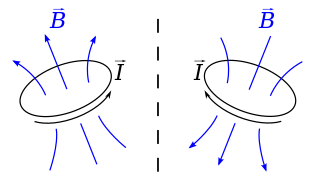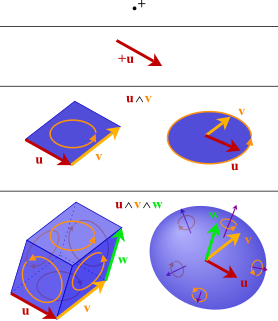See also
| This disambiguation page lists mathematics articles associated with the same title. If an internal link led you here, you may wish to change the link to point directly to the intended article. |
The cross product is a product in vector algebra.
Cross product may also refer to:
| This disambiguation page lists mathematics articles associated with the same title. If an internal link led you here, you may wish to change the link to point directly to the intended article. |
The geometric algebra (GA) of a vector space is an algebra over a field, noted for its multiplication operation called the geometric product on a space of elements called multivectors, which contains both the scalars and the vector space . Mathematically, a geometric algebra may be defined as the Clifford algebra of a vector space with a quadratic form. Clifford's contribution was to define a new product, the geometric product, that united the Grassmann and Hamilton algebras into a single structure. Adding the dual of the Grassmann exterior product allows the use of the Grassmann–Cayley algebra, and a conformal version of the latter together with a conformal Clifford algebra yields a conformal geometric algebra (CGA) providing a framework for classical geometries. In practice, these and several derived operations allow a correspondence of elements, subspaces and operations of the algebra with geometric interpretations.
In mathematics, an identity element, or neutral element, is a special type of element of a set with respect to a binary operation on that set, which leaves any element of the set unchanged when combined with it. This concept is used in algebraic structures such as groups and rings. The term identity element is often shortened to identity, when there is no possibility of confusion, but the identity implicitly depends on the binary operation it is associated with.

In mathematics, physics and engineering, a Euclidean vector is a geometric object that has magnitude and direction. Vectors can be added to other vectors according to vector algebra. A Euclidean vector is frequently represented by a ray, or graphically as an arrow connecting an initial pointA with a terminal pointB, and denoted by .
Vector calculus, or vector analysis, is concerned with differentiation and integration of vector fields, primarily in 3-dimensional Euclidean space The term "vector calculus" is sometimes used as a synonym for the broader subject of multivariable calculus, which includes vector calculus as well as partial differentiation and multiple integration. Vector calculus plays an important role in differential geometry and in the study of partial differential equations. It is used extensively in physics and engineering, especially in the description of electromagnetic fields, gravitational fields, and fluid flow.
In mathematics, the octonions are a normed division algebra over the real numbers, meaning it is a hypercomplex number system; Octonions are usually represented by the capital letter O, using boldface O or blackboard bold . Octonions have eight dimensions; twice the number of dimensions of the quaternions, of which they are an extension. They are noncommutative and nonassociative, but satisfy a weaker form of associativity; namely, they are alternative. They are also power associative.

In mathematics, the cross product or vector product is a binary operation on two vectors in three-dimensional space , and is denoted by the symbol . Given two linearly independent vectors a and b, the cross product, a × b, is a vector that is perpendicular to both a and b, and thus normal to the plane containing them. It has many applications in mathematics, physics, engineering, and computer programming. It should not be confused with the dot product.

In physics and mathematics, a pseudovector is a quantity that transforms like a vector under a proper rotation, but in three dimensions gains an additional sign flip under an improper rotation such as a reflection. Geometrically, the direction of a reflected pseudovector is opposite to its mirror image, but with equal magnitude. In contrast, the reflection of a true vector is exactly the same as its mirror image.
In database theory, relational algebra is a theory that uses algebraic structures with a well-founded semantics for modeling the data, and defining queries on it. The theory has been introduced by Edgar F. Codd.
In mathematics, an algebra over a field is a vector space equipped with a bilinear product. Thus, an algebra is an algebraic structure consisting of a set together with operations of multiplication and addition and scalar multiplication by elements of a field and satisfying the axioms implied by "vector space" and "bilinear".

In mathematics, the exterior product or wedge product of vectors is an algebraic construction used in geometry to study areas, volumes, and their higher-dimensional analogues. The exterior product of two vectors u and v, denoted by u ∧ v, is called a bivector and lives in a space called the exterior square, a vector space that is distinct from the original space of vectors. The magnitude of u ∧ v can be interpreted as the area of the parallelogram with sides u and v, which in three dimensions can also be computed using the cross product of the two vectors. Like the cross product, the exterior product is anticommutative, meaning that u ∧ v = −(v ∧ u) for all vectors u and v, but, unlike the cross product, the exterior product is associative. One way to visualize a bivector is as a family of parallelograms all lying in the same plane, having the same area, and with the same orientation—a choice of clockwise or counterclockwise.
In mathematics, multilinear algebra extends the methods of linear algebra. Just as linear algebra is built on the concept of a vector and develops the theory of vector spaces, multilinear algebra builds on the concepts of p-vectors and multivectors with Grassmann algebra.
The multiplication sign, also known as the times sign or the dimension sign, is the symbol ×, used in mathematics to denote the multiplication operation and its resulting product. While similar to a lowercase X, the form is properly a rotationally symmetric saltire.
In mathematics, a von Neumann algebra or W*-algebra is a *-algebra of bounded operators on a Hilbert space that is closed in the weak operator topology and contains the identity operator. It is a special type of C*-algebra.
In vector algebra, a branch of mathematics, the triple product is a product of three 3-dimensional vectors, usually Euclidean vectors. The name "triple product" is used for two different products, the scalar-valued scalar triple product and, less often, the vector-valued vector triple product.
In mathematics, vector algebra may mean:
In mathematics, the seven-dimensional cross product is a bilinear operation on vectors in seven-dimensional Euclidean space. It assigns to any two vectors a, b in a vector a × b also in . Like the cross product in three dimensions, the seven-dimensional product is anticommutative and a × b is orthogonal both to a and to b. Unlike in three dimensions, it does not satisfy the Jacobi identity, and while the three-dimensional cross product is unique up to a sign, there are many seven-dimensional cross products. The seven-dimensional cross product has the same relationship to the octonions as the three-dimensional product does to the quaternions.
In mathematics, there are usually many different ways to construct a topological tensor product of two topological vector spaces. For Hilbert spaces or nuclear spaces there is a simple well-behaved theory of tensor products, but for general Banach spaces or locally convex topological vector spaces the theory is notoriously subtle.
In mathematics, and more specifically in the theory of von Neumann algebras, a crossed product is a basic method of constructing a new von Neumann algebra from a von Neumann algebra acted on by a group. It is related to the semidirect product construction for groups.

Three-dimensional space is a geometric setting in which three values are required to determine the position of an element. This is the informal meaning of the term dimension.
In mathematics, a sequence of n real numbers can be understood as a location in n-dimensional space. When n = 7, the set of all such locations is called 7-dimensional space. Often such a space is studied as a vector space, without any notion of distance. Seven-dimensional Euclidean space is seven-dimensional space equipped with a Euclidean metric, which is defined by the dot product.